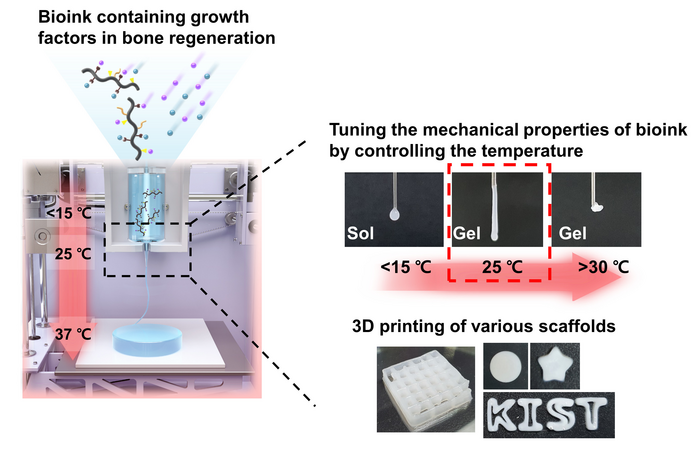The advancement of biomaterials for artificial organs and tissues is active due to the rise in injuries and chronic diseases, together with the entry into a super-aged society.

Tuning mechanical properties of bioink according to temperature and 3D scaffold printing. Image Credit: Korea Institute of Science and Technology
The use of cells and biomaterials to build three-dimensional artificial tissue constructs, known as 3D bioprinting, has lately gained popularity. However, the chemical crosslinking agent and ultraviolet light that link the molecular structure of photocuring 3D-printed bioink can cause cytotoxicity in frequently used hydrogel-based bioinks.
Dr. Song Soo-chang’s group at the Center for Biomaterials, Korea Institute of Science and Technology (KIST, President Yoon Seok-jin), disclosed the first development of poly(organophosphazene) hydrogel-based temperature-sensitive bioink that efficiently retained its physical structure only by temperature control without photocuring, stimulating tissue regeneration, and then biodegraded in the body over a certain period of time.
Existing hydrogel-based bioinks must undergo a photocuring procedure after printing to improve the mechanical properties of the 3D scaffold, which poses a high risk of deleterious consequences to the human body. Furthermore, there is a risk of negative effects from transplanting externally cultured cells within bioink to accelerate tissue regeneration.
As a result, the researchers created a new bioink material out of a temperature-sensitive poly(organophosphazene) hydrogel that persisted as a liquid at low temperatures and transformed into a hard gel at body temperature.
This allowed for tissue regeneration using only temperature control and no chemical crosslinking agents or UV irradiation, as well as the creation of a three-dimensional scaffold with a physically stable structure, reducing the risk of immune adverse effects in the human body.
The new bioink also contained a molecular structure that allowed it to interact with growth factors, which are proteins that aid in tissue regeneration by preserving growth factors that regulate cell growth, differentiation, and immune responses over time.
By developing an environment in which cell differentiation could be autonomously managed within the 3D scaffold printed with bioink, the research team was able to optimize the efficacy of tissue regeneration.
The 3D scaffold was created by printing it with a 3D bioprinter using bioink comprising transforming growth factor beta 1 (TGF-β1) and bone morphogenetic protein-2 (BMP-2), which were essential for cell infiltration and bone regeneration, and then implanting it into a broken bone in a rat. As a result, cells from the surrounding tissue migrated into the scaffold, the defective bone was restored to normal tissue levels, and the implanted 3D scaffold biodegraded slowly in the body over 42 days.
The research team has transferred technology for the thermo-sensitive polyphosphazene hydrogel to NexGel Biotech Co., Ltd. in June 2022, and the development of products such as bone graft materials and cosmetic fillers is underway. As the bioink developed this time has different physical properties, follow-up research to apply it to the regeneration of other tissues besides bone tissue is being conducted, and we expect to finally be able to commercialize bioink tailored to each tissue and organ.”
Dr. Song Soo-Chang, Korea Institute of Science and Technology
Source:
Journal reference:
- Kim, J., et al. (2022). Thermo‐Responsive Nanocomposite Bioink with Growth‐Factor Holding and its Application to Bone Regeneration. Small. doi.org/10.1002/smll.202203464.